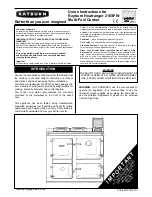
Detection
The first indication of a chimney fire is usually the noise -
a roaring sound that grows louder as the fire’s intensity
increases. Clouds of black smoke and sparks will be seen
exiting the top of the chimney; in severe fires, flames can
several feet about the chimney.
Action
In case of a chimney fire follow these steps but do not put
yourself or others in peril.
1. Call the fire brigade immediately.
2. Get everyone out of the property.
3. Close down the air supply to the appliance i.e. the
primary air spinner and the flue damper. Limiting the
fire’s air supply will reduce its intensity. If there is a
damper in the chimney connector, plug or close the
opening.
4. If a fire extinguisher is available, open the appliance
door just enough to insert the nozzle of a 4 kg dry
chemical fire extinguisher rated for Class ABC fires.
Discharge the entire content of the extinguisher into
the appliance and shut the door.
5. If possible, wet down the roof and other outside
combustibles to prevent fires ignited by shooting
sparks and flames.
6. Closely monitor all combustible surfaces near the
chimney. During severe chimney fires, these surfaces
can become hot enough to ignite.
After a chimney fire, have the chimney inspected by a
professional sweep or cooker installer.
The cooker has been designed to provide a satisfactory
supply of domestic hot water with or without a limited
amount of heating with a normal day’s cooking providing
the cooker is kept alight overnight and the system
complete with lagged cylinder conforms to the installation
instructions.
In some circumstances it may be possible to overheat the
appliance and the water inside will boil. This will be evident
by the sound of a knocking noise coming from the
appliance and pipes around the house. If this occurs, close
off all air controls and manually start the central heating
pump if fitted. Opening the oven doors and hotplate covers
will help to release heat from the appliance. Be aware that
steam and boiling water will be expended from any open
vent from the heating system probably in the roof space at
the expansion tank.
Always use a qualified service/heating engineer when
servicing is required. Use only authorised replacement
parts. Do not make unauthorised modifications.
To Replace Grate Bars
1. Dump the grate assembly as described in
1
,
2
and
3
under ‘To Dump the Grate - Clinker Removal’.
2. Lift up and draw forward the firebar in question and
replace new firebar in reverse manner.
To Replace Grate Bar Support Frame
1. Dump the grate assembly as described in
1
,
2
and
3
under ‘
TO DUMP THE GRATE - CLINKER
REMOVAL
’.
2. Lift up and withdraw all the grate bars from the cooker.
3. Lift the support frame from its rear pivot support and
withdraw until clear of ashpit.
4. Insert new frame ensuring its pivot/supported at rear.
5. Replace firebars ensuring they are in correct order.
6. Lift grate assembly (as described in
4
and
5
under ‘
TO
DUMP THE GRATE CLINKER’.
Properly installed and operated, this cooker will not emit
fumes.
Occasionally fumes from de-ashing and re-fuelling may
occur, but persistent fume emission must not be tolerated.
If fume emission does persist, then the following
immediate action should be taken:-
a) Open doors and windows to ventilate room.
b) Let the fire out or remove lit fuel from cooker.
c) Check for flue or chimney blockage and clean if
required.
d) Do not attempt to relight the fire until cause of fumes
has been been identified, and if necessary seek
professional advice.
Part Number
Description
No Req’d
RS4M 22093
Bottomgrate Bars Top
4
RS4M 22094
Bottomgrate Bars Bottom
3
RS4F3-13507
Oven Side Firebricks (Fixed)
2
RS4F4-13508
Firebox Side Top Firebrick
1
RS4F3-13509
Front Firebrick
1
RS4F3-13507
Boiler Side Firebricks
2
(Removeable)
RS1M91905
Ashpan 2
RSFM61
Operating Tool
1
Replacement parts if required are available from your
local stockist.
8
SERVICING
FUME EMISSION WARNING
SPARES LIST
Fig. 14
HOT WATER SERVICE






























